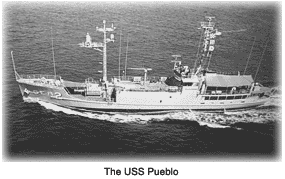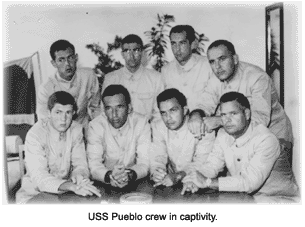In January 1968, the USS Pueblo, a former cargo freighter converted into an environmental research/intelligence-gathering vessel, became the first U.S. Navy ship to be seized by foreign armed forces since December 1941. It was clearly in international waters, as confirmed by navigational equipment, on a mission to monitor communist vessels in transit and intercept messages in the Tsushima Straits off North Korea.
Background
The tumultuous 1960s, with their idealistic expectations, were about to give way to the disillusioned '70s. The year 1968 proved to be a transition between two eras.
In the midst of the Vietnam War, the United States was struggling mightily with at least three key concepts: its role as “world cop,” stalling the spread of communism, and its support of emerging third-world nations.
In June 1967, the USS Liberty, also an intelligence-gathering, non-combatant ship flying the American flag, was attacked by Israel during the Six Day War. Inexplicably, air fighter support for the Liberty was called off. That would not bode well for the Pueblo.
In 1967, North Korea violated the armistice agreement with South Korea more than 500 times. U.S. intelligence chose to ignore those incidents.
 January 1968
With newly installed surveillance gear in a metal room dubbed the “Sod Hut,” the Pueblo was involved in “Operation Clickbeetle,” a mission with a risk level rated “minimal,” 15 miles off the coast of North Korea.
Due to ionospheric conditions in the frigid Sea of Japan, communications were disrupted. With one day left on its mission, military officials decided to not inform the Pueblo that less than 48 hours before, 31 North Koreans in South Korean uniforms had infiltrated the DMZ and come to within one block of the Blue House, the South Korean equivalent to the White House, in an attempt to assassinate the South Korean president.
On January 23, four North Korean subchasers and torpedo boats surrounded the Pueblo. When it became apparent that the unarmed (except for a relatively small 50-caliber machine gun) American spy ship was about to be commandeered by the North Koreans, a wealth of sensitive information and equipment had to be destroyed.
Delaying tactics ordered by Commander Lloyd M. "Pete" Bucher were designed to give the crew more time with which to shred and incinerate documents, even dumping some overboard. At first, the Pueblo tried evasive maneuvers to escape, but the smaller, faster, and more maneuverable North Korean boats circumvented the effort.
January 1968
With newly installed surveillance gear in a metal room dubbed the “Sod Hut,” the Pueblo was involved in “Operation Clickbeetle,” a mission with a risk level rated “minimal,” 15 miles off the coast of North Korea.
Due to ionospheric conditions in the frigid Sea of Japan, communications were disrupted. With one day left on its mission, military officials decided to not inform the Pueblo that less than 48 hours before, 31 North Koreans in South Korean uniforms had infiltrated the DMZ and come to within one block of the Blue House, the South Korean equivalent to the White House, in an attempt to assassinate the South Korean president.
On January 23, four North Korean subchasers and torpedo boats surrounded the Pueblo. When it became apparent that the unarmed (except for a relatively small 50-caliber machine gun) American spy ship was about to be commandeered by the North Koreans, a wealth of sensitive information and equipment had to be destroyed.
Delaying tactics ordered by Commander Lloyd M. "Pete" Bucher were designed to give the crew more time with which to shred and incinerate documents, even dumping some overboard. At first, the Pueblo tried evasive maneuvers to escape, but the smaller, faster, and more maneuverable North Korean boats circumvented the effort.
 Following the seizing of the vessel, the North Koreans directed Bucher to steer toward Wonsan. Bucher crept along at one-third speed and finally stopped just outside Korean waters. He was trying to gain valuable time for the crew to destroy the documents and equipment. This action prompted the North Koreans to open fire on the Pueblo. One crewman, Duane Hodges, was killed; the other 82 seamen were taken prisoner.
No discernible rescue efforts were attempted by the U.S., until two days later when a naval task force was sent to bolster military forces in South Korea.
Ill-treated prisoners
Upon landing at Wonson, the prisoners were led, bound and blindfolded, through a hostile crowd of jeering civilians. Hispanic crew members were attacked by soldiers who thought they were South Koreans.
In the prison compound in Pyongyang, the daily routine was to awaken a 6 a.m. for a breakfast of turnips, more turnips at 2 p.m. and 8 p.m., and to bed at 10 p.m. The men sat all day at a small table with four chairs and a cup of water. They were ordered to keep their heads bowed and to remain silent. They were marched to the bathroom twice a day.
False confessions were forced by beatings. The “confessions,” however, were cleverly worded by the prisoners with slang and colloquialisms that would tip off anyone reading them that the disclosures were bogus.
After six weeks, the men were moved to a second compound where they would remain for another 42 weeks. Breakfast “improved” to two slices of brown bread served with rancid butter, a lunch of turnip soup or a tea saucer of rice and sliced turnip for four people, and a dinner of oily turnip soup, sometimes served with an eyeball of a slaughtered hog. On occasion, they were served “sewer trout” (rotting mackerel).
The crew developed the “Hawaiian Good Luck Sign” to show their disdain for being forced to lie on television interviews. The “sign” was also described as the “single finger salute” and was not noticed by Korean interrogators.
Hell Week
The brutality worsened, beginning on December 12. The men were beaten, kicked, hit with boards and made to kneel with poles behind their knees while the guards jumped up and down on the ends. Abruptly, the punishment ended on December 19.
Following the seizing of the vessel, the North Koreans directed Bucher to steer toward Wonsan. Bucher crept along at one-third speed and finally stopped just outside Korean waters. He was trying to gain valuable time for the crew to destroy the documents and equipment. This action prompted the North Koreans to open fire on the Pueblo. One crewman, Duane Hodges, was killed; the other 82 seamen were taken prisoner.
No discernible rescue efforts were attempted by the U.S., until two days later when a naval task force was sent to bolster military forces in South Korea.
Ill-treated prisoners
Upon landing at Wonson, the prisoners were led, bound and blindfolded, through a hostile crowd of jeering civilians. Hispanic crew members were attacked by soldiers who thought they were South Koreans.
In the prison compound in Pyongyang, the daily routine was to awaken a 6 a.m. for a breakfast of turnips, more turnips at 2 p.m. and 8 p.m., and to bed at 10 p.m. The men sat all day at a small table with four chairs and a cup of water. They were ordered to keep their heads bowed and to remain silent. They were marched to the bathroom twice a day.
False confessions were forced by beatings. The “confessions,” however, were cleverly worded by the prisoners with slang and colloquialisms that would tip off anyone reading them that the disclosures were bogus.
After six weeks, the men were moved to a second compound where they would remain for another 42 weeks. Breakfast “improved” to two slices of brown bread served with rancid butter, a lunch of turnip soup or a tea saucer of rice and sliced turnip for four people, and a dinner of oily turnip soup, sometimes served with an eyeball of a slaughtered hog. On occasion, they were served “sewer trout” (rotting mackerel).
The crew developed the “Hawaiian Good Luck Sign” to show their disdain for being forced to lie on television interviews. The “sign” was also described as the “single finger salute” and was not noticed by Korean interrogators.
Hell Week
The brutality worsened, beginning on December 12. The men were beaten, kicked, hit with boards and made to kneel with poles behind their knees while the guards jumped up and down on the ends. Abruptly, the punishment ended on December 19.
 Repatriation
On December 22, after nearly 11 months of negotiations by President Lyndon B. Johnson, an agreement was made to release the prisoners. The next day, one by one, every 15 seconds, the crew of the Pueblo walked across the Bridge of No Return, thus gaining their freedom. The brutally beaten seamen were released to a hero's welcome and potential courts martial (none was held).
The USS Pueblo remains in North Korean custody.
Repatriation
On December 22, after nearly 11 months of negotiations by President Lyndon B. Johnson, an agreement was made to release the prisoners. The next day, one by one, every 15 seconds, the crew of the Pueblo walked across the Bridge of No Return, thus gaining their freedom. The brutally beaten seamen were released to a hero's welcome and potential courts martial (none was held).
The USS Pueblo remains in North Korean custody.